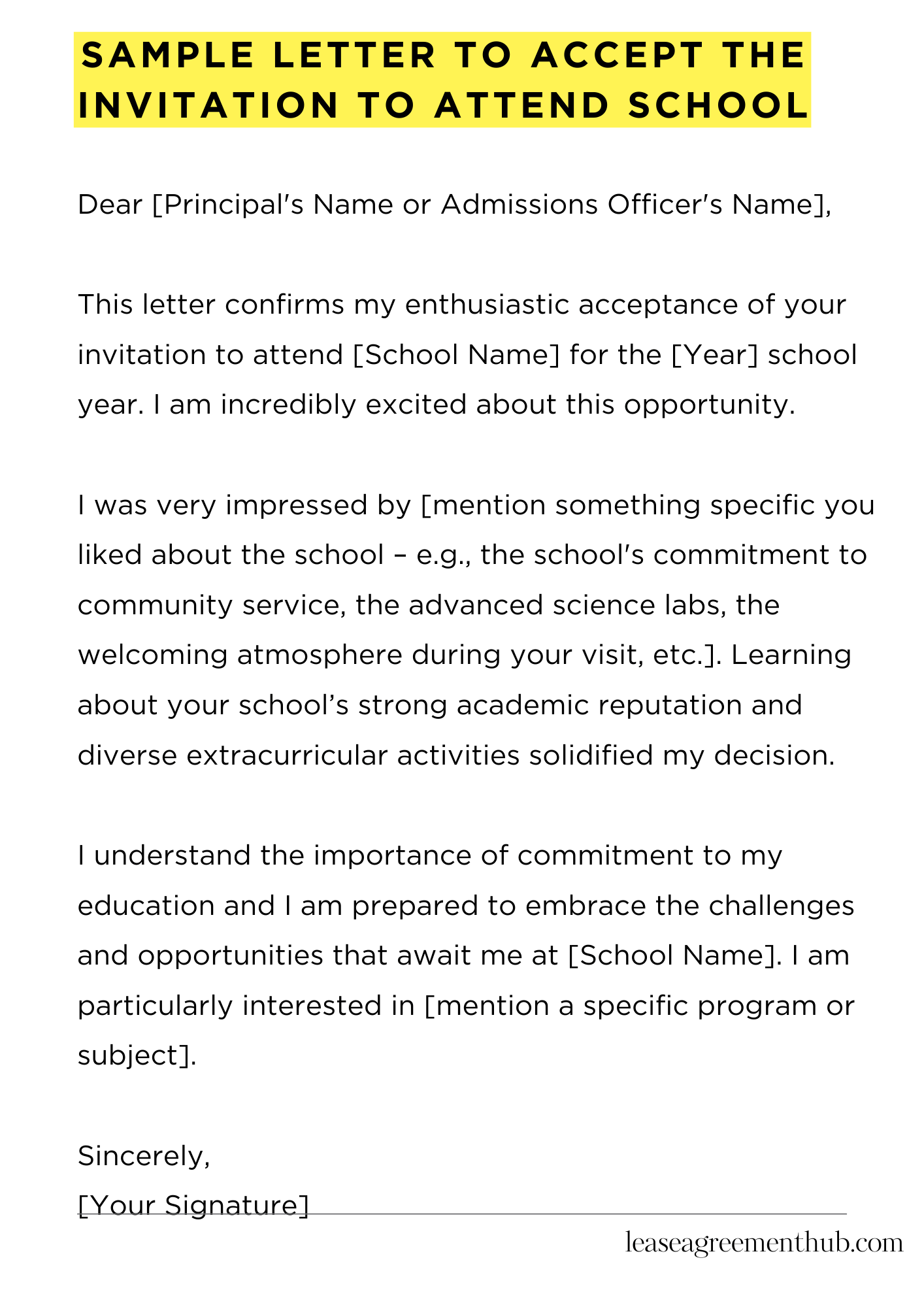A sample acceptance letter confirms your child’s spot in school. It’s a formal way to say “yes” to the offer.
This article gives you examples. We provide templates. These help you write your own letter easily.
Use our samples as a guide. Create a perfect acceptance letter. It’s simple and straightforward.
Sample Letter to Accept the Invitation to Attend School
[Your Name]
[Your Address]
[Your Phone Number]
[Your Email Address]
[Date]
[School Name]
[School Address]
Dear [Principal’s Name or Admissions Officer’s Name],
This letter confirms my enthusiastic acceptance of your invitation to attend [School Name] for the [Year] school year. I am incredibly excited about this opportunity.
I was very impressed by [mention something specific you liked about the school – e.g., the school’s commitment to community service, the advanced science labs, the welcoming atmosphere during your visit, etc.]. Learning about your school’s strong academic reputation and diverse extracurricular activities solidified my decision.
I understand the importance of commitment to my education and I am prepared to embrace the challenges and opportunities that await me at [School Name]. I am particularly interested in [mention a specific program or subject]. I am confident that I will be a valuable addition to your school community.
Thank you again for offering me this privilege. I look forward to beginning my studies at [School Name] in [Month]. Please let me know if any further information or action is required from my side.
Sincerely,
[Your Signature]
How to Write a Sample Letter to Accept the Invitation to Attend School
Understanding the Nuances of Acceptance
Accepting a school invitation isn’t merely a formality; it’s a pivotal declaration signifying your commitment to academic pursuits. A well-crafted acceptance letter demonstrates professionalism and respect, setting the tone for your educational journey. It needs to be succinct, yet comprehensive, avoiding both vagueness and superfluity.
Essential Components: Crafting a Persuasive Acceptance
Your letter should contain specific information, eschewing ambiguity. Begin with a formal salutation, addressing the relevant authority (e.g., “Dear Admissions Committee”). Clearly state your intent to accept the offer of admission. Mention the specific program or course you’ll be attending. This precision is paramount, preventing any future misunderstandings. End with a courteous closing, like “Sincerely,” followed by your signature and typed name.
Structuring Your Correspondence: A Logical Approach
A structured approach is crucial. Begin with a concise opening paragraph expressing your elation at receiving the acceptance. The subsequent paragraph should reiterate your acceptance and mention the program. Conclude with a brief expression of enthusiasm and anticipation for your upcoming studies. Keep your paragraphs short and to the point. Avoid verbose language; clarity trumps circumlocution.
Enhancing Your Letter: Adding a Personal Touch
While formality is essential, a touch of personalization can make your letter stand out. Briefly mention something specific that excites you about the school – a particular program, a renowned faculty member, or a unique aspect of the campus. This demonstrates genuine interest, moving beyond a generic acceptance.
Addressing Specific Requests: Handling Contingencies
If the acceptance letter requires additional information or actions (like submitting further documentation), address these explicitly. Mention completion of requested actions and include the dates of submission if appropriate. This proactive approach shows diligence and organizational prowess.
Review and Refine: Polishing Your Prose
Before sending, meticulously review your letter. Proofread for grammatical errors and typographical slips. A polished letter reflects positively on you. Ask a trusted friend or mentor to review it for clarity and tone. Ensure your message is grammatically impeccable and stylistically refined.
Sample Letter: A Practical Example
[Your Name]
[Your Address]
[Your Phone Number]
[Your Email Address]
[Date]
Admissions Committee
[School Name]
[School Address]
Dear Admissions Committee,
I am writing to express my immense gratitude for your offer of admission to the [Program Name] program at [School Name]. I am thrilled to accept this opportunity and look forward to beginning my studies in [Month, Year].
I am particularly excited about [Mention something specific you’re looking forward to]. I believe that [School Name]’s commitment to [Mention a school value] aligns perfectly with my academic aspirations.
Thank you again for this incredible opportunity. I eagerly anticipate joining the [School Name] community.
Sincerely,
[Your Signature]
[Your Typed Name]
FAQs about sample letter to accepting the invitation to attend school
Accepting a school invitation requires a formal response. Below are five frequently asked questions regarding the content and structure of such a letter.
What information should I include in my acceptance letter?
Your acceptance letter should include your full name, the school’s name, the program you’ve been accepted into, your clear confirmation of acceptance, and the date. It’s also polite to express your enthusiasm for attending and, optionally, mention any relevant details like your expected arrival date or any specific questions you may have.
What is the appropriate tone for an acceptance letter?
Maintain a formal and respectful tone throughout the letter. Avoid slang or overly casual language. Express your gratitude for the opportunity and convey professionalism in your communication.
Should I send a hard copy or an email?
The preferred method of communication is often specified in the school’s invitation. If not, an email is generally acceptable, but sending a formal letter may be considered more courteous, especially for prestigious institutions. Check the school’s instructions carefully.
How long should my acceptance letter be?
Keep your acceptance letter concise and to the point. A well-written letter should be brief, typically no more than one page long, aiming for clarity and professionalism rather than length.
What if I need to make changes to my enrollment after accepting?
If you need to make any changes to your enrollment after submitting your acceptance, contact the school’s admissions office immediately. Explain your situation clearly and follow their instructions for modifying your enrollment details. Prompt communication is crucial in such situations.
Related: